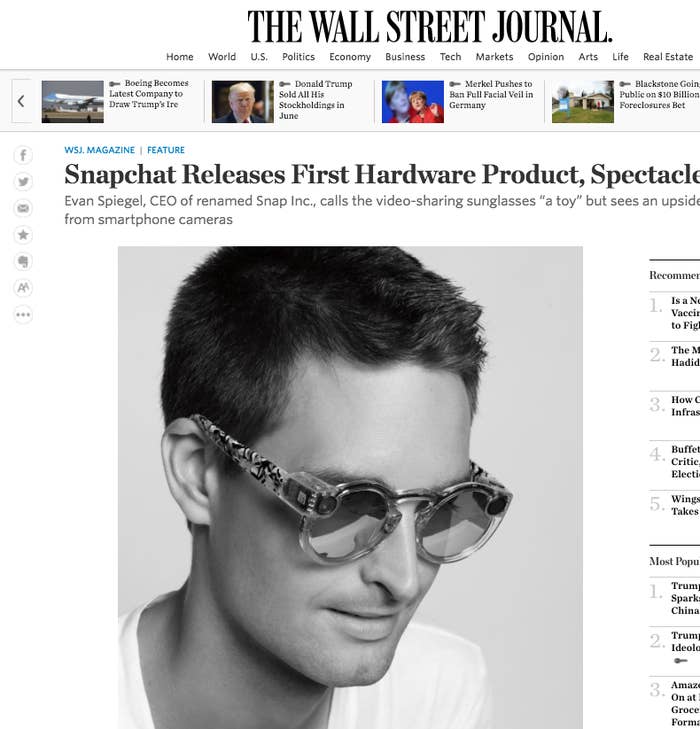
Snap is in the midst of a pre-IPO marketing push so masterful it will likely be taught in business schools for years to come. The company's unofficial roadshow kicked off with a product story in the Wall Street Journal introducing Spectacles, its new sunglass-with-a-camera product. The Spectacles announcement and limited rollout created a massive hype cycle, solidifying a narrative that Snap can do no wrong as it prepares to hit the public market at an expected $25 billion valuation. But Snap will be valued based off ad sales not Spectacles sales and, with history as a guide, the hype may come back to bite it.
To see the sort of a disaster a much-hyped IPO can lead to for an emerging social company, you need only to look to Twitter’s November 2013 offering. Twitter, at the time, was still on a victory tour of its centrality to the 2012 election, and it did little to temper investor’s exuberant enthusiasm. On the day of Twitter’s IPO, then–Twitter CEO Dick Costolo told CNBC the company was experiencing “consistent, tremendous growth” and wanted to “enable the 2.3 billion connected people in the world to all become users of the platform.”
The consensus that Twitter was bound to continue growing users and revenue helped its stock rise 73% on its first day of trading, leaving it with a market cap of $24.4 billion by the end of the day — almost exactly where Snap is expected to start off. But the pressure to live up those lofty growth expectations became debilitating for Twitter relatively quickly, and it has spent almost the entire time since trying to explain why it has not met them. Three years later, Twitter has a market cap of $13 billion, about half of what it was worth on IPO day. After so much hype, its business never came close to matching Costolo’s predictions.
The parallels between Twitter and Snap are easy to miss if you're enamored of Spectacles, but hard to dismiss once you look at the overall business. Snap, like Twitter, is an emerging social platform with significant cultural relevance but without the user numbers to match, thanks in part to a difficult-to-use product. Snapchat, like Twitter, appeals to a big but ultimately niche audience: Twitter appeals to newshounds, Snap to young people. And perhaps most important: Snap is bringing a largely unproven set of ad products to an online advertising game dominated by Google and Facebook; platforms that are so effective, advertisers told BuzzFeed News there’s a fat chance they’ll move large portions of their budgets anywhere else.
“The Twitter comparison is apt,” Kyle Bunch, of the ad agency R/GA, told BuzzFeed News. Bunch, who manages social platforms for the 2,000-person agency, said Twitter is in advertising plans for virtually all of R/GA’s clients, but Facebook's and Google’s data and optimization capabilities have made spending money with them almost formulaic; X dollars in ads on those platforms gets you Y dollars in sales. Sure enough, 85 cents of every incremental ad dollar spent online is going to those two companies, according to Morgan Stanley analyst Brian Nowak. “It’s easy for advertisers to become essentially addicted to Facebook and Google and it’s really hard to cut back,” Bunch said.
All Sorts Of Challenges
Conversations with multiple advertisers revealed that Snap has a number of obstacles to overcome before it can be anything more than a fly for Google and Facebook to swat away.
Advertisers do not like the fact that Snap’s Snapchat ads are skippable. Though video ads on Snapchat can run for 10 seconds, people actually watch them for an average of less than 3, according to an Ad Age report that BuzzFeed News confirmed with multiple advertisers. When advertisers spend money, they are accustomed to force-feeding their messaging down consumers' throats. Three seconds on Facebook isn’t even considered a view, and so three seconds on Snapchat is hard to work with.
Snapchat also exists largely as a black hole, where users go in and don't come out via links like they do on Google, Facebook, and even Twitter. Snapchat has made improvements to its ad platform in recent months, opening up an API to allow for better measurement, but it’s going to have difficulty attracting advertisers who need their ad spend to translate to web visits.
And then there’s the Facebook issue. Since Facebook cloned Snapchat Stories in Instagram, Snapchat Story views have gone down for brands, one ad pro told BuzzFeed News. Another agency executive said that Instagram Stories makes him doubt Snapchat can sustain its audience growth.
Because of these weaknesses, Snap has been unable to break out of the “experimental” portion of many advertisers’ budgets, according to the agency executive. These budgets, the agency executive said, get portioned out based on a 70–20–10 rule: 70% of advertiser budgets is spent inside platforms that are tried and true, 20% is spent with platforms that are still emerging, and 10% in spent in the next/innovation bucket. “I would bet that most still put Snapchat in that 10%,” the agency executive said. “For us, Facebook is in that 70% and Snapchat is nowhere near that.”
Snap’s weaknesses have also made it entirely unappealing to other companies whose bread and butter is online advertising. Groupon, for instance, spends hundreds of millions of dollars a year on advertising but only a “tiny, tiny, tiny” amount of money on Snapchat, according to its CEO, Rich Williams. And Socialflow, a social platform that spends millions boosting content on social platforms, looked into Snapchat as a potential place to spend money, but it’s found no use for the platform so far. “There is a large barrier to entry to advertising on Snapchat,” Jess Bahr, director of paid social at Socialflow, told BuzzFeed News. “Unfortunately, it’s seen as risky and it’s hard to tie back to revenue.”
There’s Hope, But…
Snap will still pull in $935.5 million in revenue next year and $1.76 billion in 2018, according to the research firm eMarketer. Those numbers are still short of the more than $2 billion in revenue Twitter made last year, but eMarketer analyst Catherine Boyle said that its core product, Snapchat, is different than Twitter thanks to its high concentration of millennials, an attractive demographic to advertisers. “Snapchat will reach more than half of US millennials in 2016 and those millennials will make up 70% of Snapchat’s US user base in 2016,” Boyle said. “If, in a worse-case scenario, Snapchat does not expand its user base as we expect it will and it remains mostly a millennials platform, advertisers are likely to continue investing.”
Sarah Hofstetter, CEO of the ad agency 360i, said she likes what she’s seen from the company, giving Snap credit for improving its ad development and measurement in a “ridiculously short time.”
Still, asked what marketers talk about when it comes to Snap, Hofstetter said something likely familiar to executives at Twitter, who have been trying to make their product more usable for years. “Most marketers still today ask for a tutorial on it,” she said. “Their kids are on it but they don’t know how to use it.”
In one of business’s great contradictions, it’s possible to screw your company over through great marketing. Snap, ready to go public, may want to closely examine Twitter’s history of doing so or it could end up in the “tough lessons” section of the business textbooks as well.
